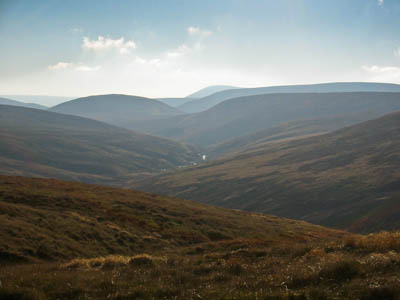
The Forest of Bowland area of outstanding natural beauty
Campaigners are urging planners to throw out an application to build wind turbines on common land in an area of outstanding natural beauty.
The Open Spaces Society has accused the power company involved of jumping the gun by planning to erect the 20 turbines before they have even determined if there is enough wind at the site. The company, Community Windpower, has applied for permission to put up a 50m (164ft) weather mast to evaluate wind levels.
The proposal is to build the turbines on Claughton Moor and Whit Moor on the north-western edge of the Forest of Bowland in Lancashire, which is designated as an area of outstanding natural beauty. The OSS is objecting to the scheme because it is in both the AONB and is on common land. The area in question is also open access land under the Countryside and Rights of Way Act.
There is an existing, smaller group of wind turbines on nearby Caton Moor.
Kate Ashbrook, the OSS’s general secretary, said: “The turbines will be a blot on Bowland. This is common land in a designated area of outstanding natural beauty and the development conflicts with both designations.
“The public has the right to walk on all commons, and people’s enjoyment of this lovely area will be ruined, not only by the turbines but by all the paraphernalia which accompanies them. Our tranquillity and feeling of escape will be destroyed.
“Furthermore, the applicants are only now applying for consent to erect a meteorological mast on the common, to assess the wind speeds. So they are applying for planning consent for the turbines when they don’t even know if there’s enough wind to support them, and before they have the Secretary of State for Environment’s consent to locate the turbines on common land.
“We trust that Lancaster City Council will reject the planning application, and that the Planning Inspectorate, on behalf of the Secretary of State for Environment, will reject the application for works on common land.”
Cheshire-based Community Windpower says the turbines would produce up to 50MW of clean power, enough to serve 25,720 homes, more than 40 per cent of Lancaster district’s houses.
It also said, in its submission: “The windfarm was designed to appear sensitive and rhythmic to the shape of the existing landscape.”
The company also said the development would provide seven permanent jobs, including an educational ranger based in Claughton. It also pointed to local support for the scheme, with two-thirds of those polled supporting the building of the wind turbines.
Common land is land subject to rights of commoners to graze animals, dig peat and take advantage of other rights. It is registered with the county or unitary authority. Before works can be erected on registered commons, planning permission must be obtained, along with consent from the Secretary of State for Environment – via the Planning Inspectorate.
Colin
16 December 2009Do OSS propose an alternative way to produce this energy?
Thought not.
Dave
17 December 2009I was born and raised in the bowlands and love them more than most. When you actually investigate what's going on here they plan is to add turbines to a hillside less than a kilometer from an existing windfarm. Right next to an area (conveniently circled out of the AONB boundry) of land raped by the permanant irreversable damage done by quarrying, it's not that pretty, but then quarrying is a necessary evil. Reading the comments made by the OSS above I do wonder how many of them have actually spent any time there!
I've walked and cycled by caton windfarms for years and find there is still 'tranquility' and 'feeling of escape' I'm not offended by the whirring of the turbines. I'm proud that we've had the common sense to build them in the first place.
I am slightly ashamed that I live in a country where the population actually band together to block the building of renewable energy plants.
The forest of bowland is a beautiful place and parts of it give people a real chance to escape to an unspoiled wilderness. Parts of it should be passionately defended. The bottom line however is quite frankly, this particular hillside won't be missed by many.
Dave
19 December 2009I would also just like to point out that even though the photo above (that looks to me like a view down whitendale) is very beautiful. It is a long way away, both geographically and in character from the hillside above caton.
I've helpfully tracked down a photo of the area in question:
http://www.wainwright-wanderings.co.uk/0115-0015.jpg
The slopes of the hillside are on the horizon line.
You can see it on it's original page with other pictures of the surrounding area and the impressive views from the existing
windfarm here:
http://www.wainwright-wanderings.co.uk/w0115.htm
The Piglit
19 December 20091. Once you can legally install something industrial in an ANOB then a dangerous precedent has been set.
2. Anyone who thinks that wind power is the answer to the coming energy crisis had better do their research. It is fraught with problems of intermittency and grid access.
Also the name "Community Windpower" is disingenuous to the point of misrepresentation. This is a Ltd Co, yes a private profit making venture.
Don't be misled into supporting something which is in the interests of private capital but which with political marketing is branded as something else.